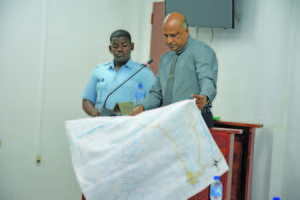Police Commissioner Seelall Persaud on Tuesday denied Police involvement in the June 2008 Lindo Creek killings, maintaining that the eight men were killed and their remains subsequently burnt by notorious prison escapee Rondell “Fine Man” Rawlins and members of his gang.
The Top Cop, who is on pre-retirement leave, appeared before the Commission of Inquiry into the Lindo Creek killings where he maintained that a team of officers, led by him, did not venture into the Lindo Creek area.

Some time between June 12, 2008 and June 24, 2008, miners Cecil Arokium, Dax Arokium, Compton Speirs, Horace Drakes, Clifton Wong, Lancelot Lee, Bonny Harry and Nigel Torres were shot and killed, and their bodies burnt at the upper Berbice River mining camp, which was being operated by Leonard Arokium.
Persaud, who was Crime Chief at the time, told the sole Commissioner, Retired Justice Donald Trotman that in June of 2008 Police Commissioner Henry Greene provided him with a map identifying Christmas Falls in the upper Berbice River area and informed him that notorious criminal Rondell “Fineman” Rawlins was in the area hiding out with his gang.
He said that he was then instructed to head an operation to arrest the prison escapee. Persaud related that he mobilised a team of six other officers and a number of civilians who were knowledgeable about the area and then ventured to the Christmas Falls area. The officers were Assistant Commissioner Clifton Hicken; Deputy Superintendent Withrite, Inspectors Layne and Narine, Assistant Superintendent Lowenfield, and Deputy Superintendent Nurse.
He said that they were all armed and took a boat with them.
The team arrived about 17:00h on June 5, 2008 and spent the night on the right bank of the Berbice River. The CoI heard that the next morning, a team led by Hicken crossed the river, made their way above Christmas Falls – which is in the Berbice River, and were engaged by a gang of men.
“I thereafter crossed the river using the same boat and observed that there was a body of a person I later learnt to be Otis Fefe (one of Rawlins’ gang members)…with what appeared to be a gunshot injury to his face, and I also observed that the ranks would have seized nine firearms consisting of rifles, handguns, and shotguns and a quantity of ammunition,” he related.
Persaud told the CoI that he then contacted Commissioner Greene and informed him of the engagement and they were told to retreat to allow the Joint Services to pursue the escapees. He further related that they retreated on June 6 and arrived in Georgetown later the same day. Additionally, the Police Commissioner said that he played no other part in that investigation and as such, he could not definitively say whether any Police rank was dispatched to the Lindo Creek area, but maintained that his team did not venture to that area.
“My ranks were not at Lindo Creek. They were at Christmas Falls. I am sure they were not there because we left on the 6th and arrived (in the city) on the 6th,” he said.
He added that the Office of Professional Responsibility (OPR) led the investigation into the Lindo Creek killings and he played no part in the initial process. The CoI heard that following the discovery of the burnt remains of the eight men, one Cecil Arokium made claims that his workers were murdered by Joint Services ranks resulting in a visit to his Tuschen, East Bank Essequibo home from then acting President Sam Hinds and a team from the OPR who took a statement.
Persaud related that he was later instructed to take over the investigation and explained that the file was forwarded to the Director of Public Prosecutions (DPP), who advised that the case be closed.
Persaud said that the advice was based on the fact that they had evidence that the eight men were killed and their remains burnt by Rawlins and his gang. He further stated that he remained convinced that the Police played no part in the men’s death; hence, the reason for closing the file.
Commissioner Trotman asked Persaud whether he was surprised at the DPP’s advice. Persaud said that he was not surprised because the Police had evidence to prove that the men were murdered by the criminal gang – most of whom were now dead.
Persaud’s answer to the question caused Commissioner Trotman to express his surprise at the advice of the DPP.
He also asked the Top Cop whether he felt the need for a coroner’s inquest into the incident, but Persaud informed that he saw no need for it, reiterating that the men were killed by “Fine Man” and his gang.
Under examination by the Commission’s Attorney, Patrice Henry, Persaud could not produce any evidence or definitively say that a post-mortem examination was conducted on the men’s remains. He also related that the men’s remains were ordered buried after the DNA results came back identifying three of them.
Persaud said that the identified remains were of Torres, Harry and another man whose name he could not recall. The CoI was told that the relatives of the three men were informed so that burial could be arranged and only one family responded, indicating that they could not afford funeral expenses; hence, the funeral parlour was instructed to bury the remains.



